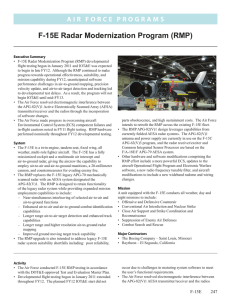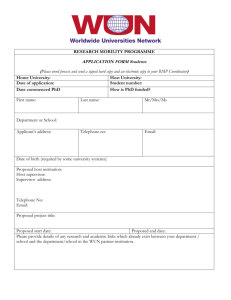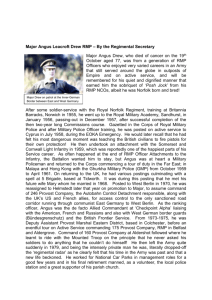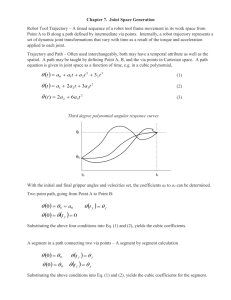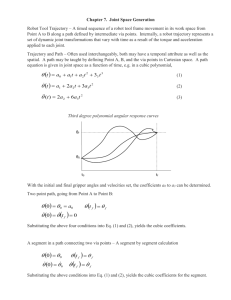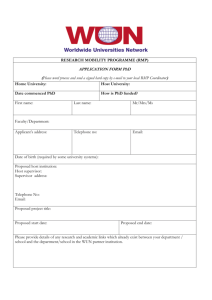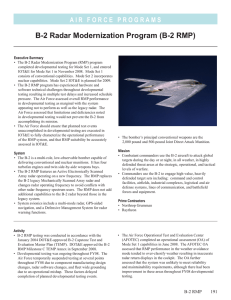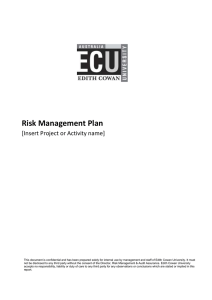F-15E Radar Modernization Program (RMP)
advertisement
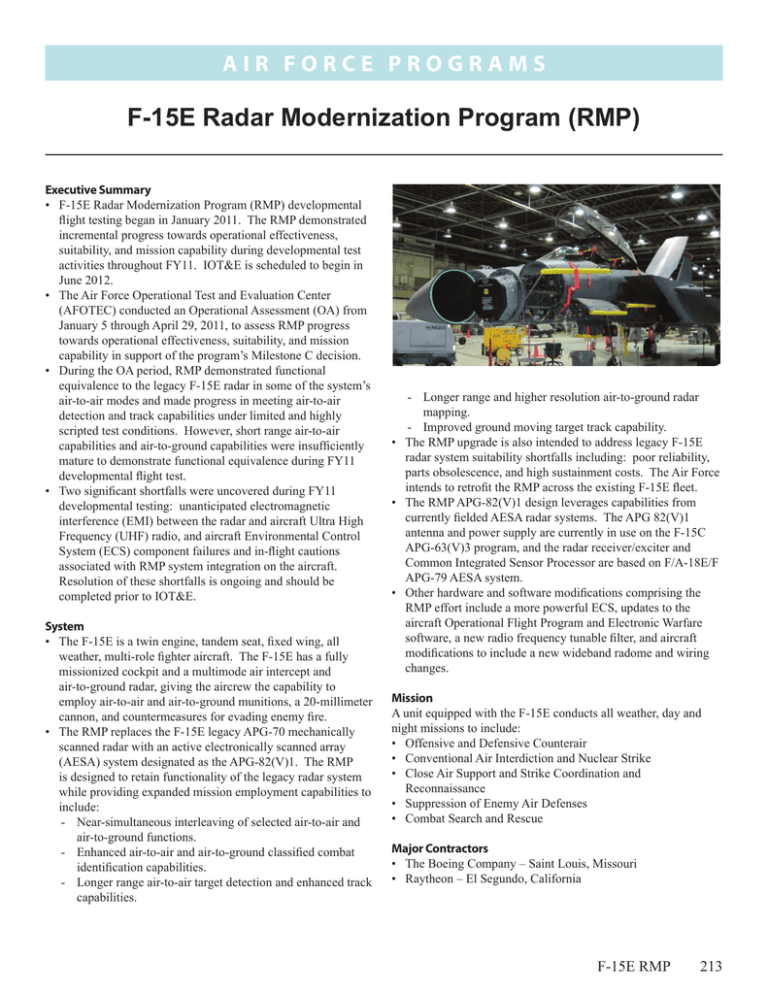
Ai r F o r c e P ROGRAMS F-15E Radar Modernization Program (RMP) Executive Summary • F-15E Radar Modernization Program (RMP) developmental flight testing began in January 2011. The RMP demonstrated incremental progress towards operational effectiveness, suitability, and mission capability during developmental test activities throughout FY11. IOT&E is scheduled to begin in June 2012. • The Air Force Operational Test and Evaluation Center (AFOTEC) conducted an Operational Assessment (OA) from January 5 through April 29, 2011, to assess RMP progress towards operational effectiveness, suitability, and mission capability in support of the program’s Milestone C decision. • During the OA period, RMP demonstrated functional equivalence to the legacy F-15E radar in some of the system’s air-to-air modes and made progress in meeting air-to-air detection and track capabilities under limited and highly scripted test conditions. However, short range air-to-air capabilities and air-to-ground capabilities were insufficiently mature to demonstrate functional equivalence during FY11 developmental flight test. • Two significant shortfalls were uncovered during FY11 developmental testing: unanticipated electromagnetic interference (EMI) between the radar and aircraft Ultra High Frequency (UHF) radio, and aircraft Environmental Control System (ECS) component failures and in-flight cautions associated with RMP system integration on the aircraft. Resolution of these shortfalls is ongoing and should be completed prior to IOT&E. System • The F-15E is a twin engine, tandem seat, fixed wing, all weather, multi-role fighter aircraft. The F-15E has a fully missionized cockpit and a multimode air intercept and air-to-ground radar, giving the aircrew the capability to employ air-to-air and air-to-ground munitions, a 20-millimeter cannon, and countermeasures for evading enemy fire. • The RMP replaces the F-15E legacy APG-70 mechanically scanned radar with an active electronically scanned array (AESA) system designated as the APG-82(V)1. The RMP is designed to retain functionality of the legacy radar system while providing expanded mission employment capabilities to include: - Near-simultaneous interleaving of selected air-to-air and air-to-ground functions. - Enhanced air-to-air and air-to-ground classified combat identification capabilities. - Longer range air-to-air target detection and enhanced track capabilities. - Longer range and higher resolution air-to-ground radar mapping. - Improved ground moving target track capability. • The RMP upgrade is also intended to address legacy F-15E radar system suitability shortfalls including: poor reliability, parts obsolescence, and high sustainment costs. The Air Force intends to retrofit the RMP across the existing F-15E fleet. • The RMP APG-82(V)1 design leverages capabilities from currently fielded AESA radar systems. The APG 82(V)1 antenna and power supply are currently in use on the F-15C APG-63(V)3 program, and the radar receiver/exciter and Common Integrated Sensor Processor are based on F/A-18E/F APG-79 AESA system. • Other hardware and software modifications comprising the RMP effort include a more powerful ECS, updates to the aircraft Operational Flight Program and Electronic Warfare software, a new radio frequency tunable filter, and aircraft modifications to include a new wideband radome and wiring changes. Mission A unit equipped with the F-15E conducts all weather, day and night missions to include: • Offensive and Defensive Counterair • Conventional Air Interdiction and Nuclear Strike • Close Air Support and Strike Coordination and Reconnaissance • Suppression of Enemy Air Defenses • Combat Search and Rescue Major Contractors • The Boeing Company – Saint Louis, Missouri • Raytheon – El Segundo, California F-15E RMP 213 Ai r F o r c e P ROGRAMS Activity • The Air Force conducted F-15E RMP testing in accordance with the DOT&E-approved Test and Evaluation Master Plan and OA plan. • The RMP began developmental flight testing on January 18, 2011. From January through July 2011, the program completed 48 of 110 planned developmental test sorties and accrued 178.6 flight test hours. • AFOTEC conducted an OA from January 5 through April 29, 2011, to assess RMP progress towards operational effectiveness, suitability, and mission capability in support of the program’s Milestone C decision. The OA consisted of developmental flight testing, hardware-in-the-loop laboratory testing, and Joint Preflight Integration of Munitions and Electronics Systems testing to evaluate RMP-configured F-15E avionics performance in a controlled electromagnetic environment. The OA flight test encompassed 39 RMP sorties and 93.2 flight test hours across five early developmental radar operational flight program software releases. • During the OA, aircrew observed severe UHF radio noise when operating in air-to-air modes during flight testing. Subsequent ground testing revealed that the noise was due to EMI between the APG-82(V)1 AESA transmitter/receiver and the radios. To resolve the problem, the program is pursuing the incorporation of software changes to the radar timeline and pulse shape in subsequent developmental testing prior to IOT&E. • The Air Force Program Executive Office granted Milestone C approval for RMP in September, 2011, authorizing low-rate initial production for the first six radar sets. • IOT&E is currently scheduled to begin in June 2012 and complete in November 2012. Assessment • The RMP demonstrated incremental progress towards achieving systems operational performance and suitability goals during FY11 developmental testing. • During the OA period, the RMP demonstrated legacy APG-70 radar functionality in long-range air-to-air and some air‑to‑ground modes as well as progress towards satisfying other RMP requirements as follows: - Qualitative aircrew surveys suggest legacy APG-70 pilot‑vehicle interface functionality has been retained. The RMP demonstrated functional equivalence to APG-70 long-range air-to-air modes and air-to-ground modes and capabilities. However, RMP within visual range (WVR) capabilities had not demonstrated similar legacy radar functionality by the end of the assessment period. - Limited quantitative performance data indicate basic long-range air-to-air detection and track capabilities against non-maneuvering targets are progressing to meet or exceed RMP specifications. Similarly, air-to-air combat identification (CID) data indicate early performance is meeting specification at ranges beyond legacy APG-70 capabilities. However, WVR target acquisition and 214 F-15E RMP track performance was generally worse than the WVR capabilities of the legacy APG-70 radar. - RMP air-to-ground capabilities were relatively immature during the assessment period, and revealed air-to-ground map quality and ground moving target track were generally worse than the legacy APG-70 system. • Several RMP capabilities were not assessed during the OA period and remain to be accomplished in post Milestone C developmental testing. These include: air-to-air and air-to‑ground weapons employment, electronic warfare capabilities, and integrated air-to-air and air-to-ground radar employment in an operationally-representative environment. • During the OA period, observed system reliability, maintainability, and availability, suggest the RMP is progressing towards meeting operational suitability requirements. However, achieving the Air Force software stability requirement by IOT&E may not be feasible. Suitability-related findings from the operational assessment include the following: - There were no hardware failures in 130.5 radar operating hours, suggesting a minimum mean time between critical failure (MTBCF) of 81.1 hours (80 percent lower confidence bound) was achieved during the assessment period. - The RMP Capabilities Production Document (CPD) specifies that RMP shall not degrade aircraft availability below that of legacy APG-70 radar-equipped F-15Es. Point estimates for aircraft availability (86.7 percent), aircraft maintainability (15.3 mean maintenance hours per flight hour), and radar system maintainability (0.13 mean maintenance hours per flight hour) satisfy that requirement. - The majority of RMP maintenance activity during the assessment period was associated with aircraft ECS component failures and in-flight cautions. Sensitivity of the legacy ECS avionics cooling monitor unit (ACMU) to RMP liquid cooling system flow rate fluctuations triggered numerous ECS cautions during in flight testing. Corrective action to modify the ACMU and aircraft software interface is ongoing and must be resolved prior to IOT&E. - The RMP mean time between software anomaly (MTBSA) point estimate of 1.15 hours at the end of the assessment period (within an 80 percent confidence interval of 0.89 to 1.51 hours) is consistent with the program’s projected software stability at this early stage of development. However, achieving the RMP CPD requirement of 30 hours MTBSA at IOT&E will require very aggressive software stability growth across the remainder of the program’s developmental test period. The RMP shares over 90 percent software code commonality with the Navy’s F/A18E/F APG-79 radar. Over the past five years, APG-79 software stability has achieved approximately 18 hours mean operating hours between operational mission failure despite an accumulated 100,000 fleet flight hours. Given RMP’s commonality with the APG-79, the pending Ai r F o r c e P ROGRAMS incorporation of air-to-ground CID and RMP anti-tamper software capabilities, and the aggressive MTBSA growth path required in the remaining developmental test period, the Air Force is not likely to meet the 30 hour MTBSA requirement. - Unexpected EMI between the RMP and the F-15E UHF radios occurred during the assessment period. When operating in air-to-air modes, UHF noise severely impeded aircrew operations. Since the end of the assessment period, the Air Force has conducted ground tests indicating radar software changes should reduce or eliminate the EMI without adversely affecting RMP performance. Resolution of this EMI problem is required prior to IOT&E. Recommendations • Status of Previous Recommendations. This is the first annual report for this program. • FY11 Recommendations. The Air Force should: 1. Continue to address and resolve ECS and UHF EMI shortfalls identified during the OA prior to IOT&E. 2. Consider either amending the RMP 30-hour MTBSA requirement or structuring the program (in particular, adding time and resources for additional development) such that it is able to achieve the desired performance measure. F-15E RMP 215 Ai r F o r c e P ROGRAMS 216
